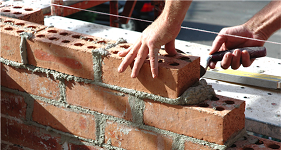Chimney Mortar Joint Repair | Re-pointing Service
|
The mortar joints on a chimney can become compromised as a result of an improperly constructed and functioning chimney cap (crown). To properly re-tuckpoint, the joints should be grinded out at least one inch, cleaned and re-pointed with an appropriate mortar for the bricks or blocks in place.
|
Concrete Chimney Caps | Chimney Crown Repair
National Building Code - Chimney Caps9.21.4.6. Chimney Caps
1) The top of a chimney shall have a waterproof cap of reinforced concrete, masonry or metal. 2) The cap required in Sentence (1) shall slope from the lining and be provided with a drip not less than 25 mm from the chimney wall. 3) Cast in place concrete caps shall be separated from the chimney liner by a bond break and be sealed at that location. |
Chimney Cap (Drip Cap, Crown) is a cast in place or precast concrete unit, or stone unit surrounding the liner at the top of a masonry chimney designed to prevent the entry of rain and snow to the area between the masonry shell and the liner.
Chimney Restoration | Chimney Construction
Brick Replacement | Brick Chimney Repairs
Bricks on a chimney can become structurally weak, the brick faces may fall off due to brick spalling, fractures in the bricks from stresses. During our brick replacement, repair service, selective bricks on the chimney are removed, the void is cleaned and repaired, and a new matching brick is installed using similar brick mortar composition and strength - type of mortar.
Leaky Chimney Repair | Masonry Water Sealing
Chimneys are a common leak location on your home. If you have water spots on your ceiling, water is dripping down your chimney or you would like to have chimney maintenance done to seal water entry points and prevent a chimney leak, contact Canadian Chimney to address your service needs.
Chimney Relining Service
The liner is located on the inside surface of the chimney. A liner must be able to withstand the high temperatures of wood burning (650 degrees Celsius) and effectively transport the flue gasses to the exterior of the home. Because of the importance of the liner to overall chimney function and longevity, it requires several important characteristics.
Clay tile liners are susceptible to thermal shock. Thermal shock occurs when the temperature of the liner rises abruptly to high levels. Such shocks can occur when a relatively cool liner is heated by a quickly kindled fire. A chimney fire also produces severe thermal shock. The liner must be able to handle many such shocks without cracking, distorting, or displacement.
Clay tile liners are susceptible to thermal shock. Thermal shock occurs when the temperature of the liner rises abruptly to high levels. Such shocks can occur when a relatively cool liner is heated by a quickly kindled fire. A chimney fire also produces severe thermal shock. The liner must be able to handle many such shocks without cracking, distorting, or displacement.




